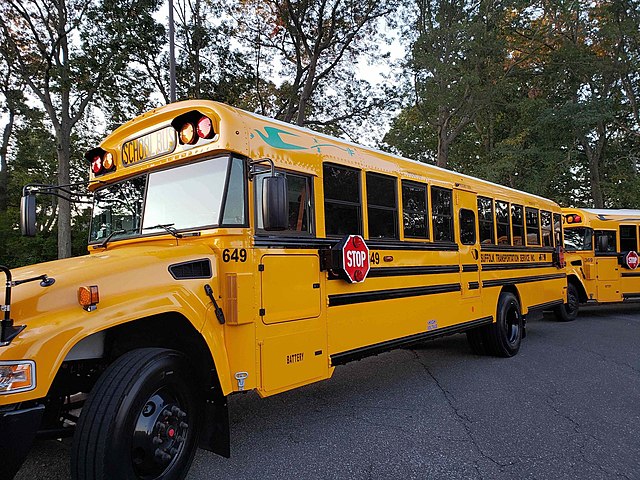New Electric Buses Join CCSDs Current Fleet
Grant a first step in improving eco-friendly transportation methods
Meeting the requirements for qualification, the Blue Bird Vision school bus is one of the models that could be introduced to the district. Due to the environmental impact of diesel engines, Automotive Technology teacher Betrand Potts gave his support in the switch to electric vehicles. “The internal combustion engine is a dirty, dirty thing,” Potts said. “Oil, gasoline, and diesel fuel all contribute to pollution, smog, and global warming. Any electric vehicle, I’m a big proponent for.” Photo Credit: Bluebird-Vision-Electric © UniversityRailroad, CC BY-SA 4.0
November 18, 2022
After receiving a grant from the Clean School Bus Program, CCSD became one of the nearly 400 districts nationwide to receive the opportunity to have eco-friendly transportation. Enacted at the end of 2021, the Clean School Bus program is an initiative funded by the United States Environmental Protection Agency meant to switch old traditional school buses with new eco-friendly models. The district received $9.875 million to pay for twenty-five new electric buses and a charging infrastructure.
“CCSD will adopt these cutting-edge transportation technologies to benefit our southern Nevada community by reducing emissions, improving air quality, and reducing environmental impacts,” Superintendent Jesus Jara said in an interview with the Las Vegas Review Journal.
Riding the bus every day, sophomore Jayden Lee recognizes the district’s eco-friendly attempts after learning about the grant.
“I would say that I am eco-friendly,” Lee said. “I try my best to help any way I can. I think having electric buses would be very beneficial to the district. The buses will be more eco friendly and overall have less problems than gas powered buses now. I believe that this is a great way for the district to help and contribute to the environment.”
With his knowledge of electric cars, Automotive Technology teacher Bertrand Potts knows some the improved efficiencies that the new electric models would have over traditional school buses.
“All the auxiliary parts and the transmission goes away,” Potts said. “You would have basically a battery pack running the electric motors that drive the wheels. Typically a Tesla Model S is good for 300 to 325 miles. If we can get that kind of range out of a school bus, that’s tremendous savings for everyone involved.”
While the intent of this program is to reduce carbon emissions, Environmental Club adviser and Environmental Science teacher Martha Horner is aware of the possible consequences of this initiative, including environmental side effects and future funding issues.
“There is an environmental trade off to everything we do,” Horner said. “Even renewables have their environmental cost. I’m not against electric vehicles in any way, I’m for smart planning and a future.”
The US Information Administration states that 61% of Nevada’s energy is produced by natural gas while only 33% is generated from solar panels. With this information, Horner doubts that the charging infrastructure for the buses will be fueled by clean energy.
“It will take decades for our energy infrastructure to be able to sustain itself using renewable resources,” Horner said. “CCSD itself may not be directly pumping the gas into those specific buses, but the charging stations that are going to ‘charge the buses with the electricity’ are majority produced at power plants that use fossil fuels.”
On top of the failure to reduce carbon emissions, the buses also exhibit more expensive prices than their traditional counterparts. While the grant pays for the upfront expenses, the district will have to fund this themselves over time.
“The infrastructure to support them can be cost prohibitive,” Horner said. “It’s $20,000 for the electric battery upwards, and the more they’re used the faster they wear out and break down. The grant is paying for it now, but what about later? Where will the schools get the money?”
In an attempt to fulfill the grant’s original desire, there are ways for students to practice being eco-friendly.
“Use a reusable water bottle for water instead of a plastic one,” Horner said. “It reduces the demand for plastic, which reduces the use of fossil fuels to produce and transport it. In the past we’ve been a very throwaway society. There’s a lot of little things that we can do as an individual to make a difference without changing our lifestyle too much.”








